Introduction
I was thrilled when I found out such a large blockchain conference would be hosted in Bogotá, a city I’ve lived in for nearly half the year. Unfortunately for me, U.S. citizens can only stay up to 180 days per year in Colombia, so I can’t go! Before my time ends here, I wanted to make a guide for others like me: visitors from outside Colombia with varying levels of experience with Spanish and Latin America. I’m not an expert in either, but I can provide some useful guidance and highlight some of my favorite parts of Bogotá.
There’s the perception outside Colombia that Bogotá just isn’t as cool as Medellín. This is false—Bogotá can get pretty cold. No but really, Bogotá is consistently around 60°F to 70°F (15.5°C to 21°C) during the day and windy. Think of it like a New York City perpetually in October (but with palm trees!). The NYC comparison isn’t as far off as you might think. NYC’s population was around 8.38 million in 2020 and Bogotá’s population was around 7.18 million in 2018. In fact, there’s no city that’s higher and more populous than Bogotá.
Coming back to my Medellín comparison, it’s hard to compete with a city nicknamed “the city of eternal spring,” but I really do prefer living in Bogotá. Bogotá feels a lot less touristic than Medellín and the diversity and sheer number of zones worth visiting is impressive. There’s really a neighborhood for everything: the historical center of La Candelaria, the trendy areas of Chapinero, Usaquén’s flea market, upscale areas like El Chicó, Zona T, Zona G, etc. I’ll give an overview of some of my favorite places in each of these areas.
Bogotá Tech & Web3 Scene
Web2
The overall tech ecosystem in Bogotá is thriving. The city has offices for all the big tech companies you can name: Google, Microsoft, Oracle, Cisco, IBM, etc. Colombia has been heavily investing in their tech workforce. In March the government announced a large certification program for Colombians looking to upskill into a tech career. Medellín has been positioning itself as the “Valley of Software” for a while, and it’s certainly been gaining steam as a popular location for remote workers.
Bogotá also has plenty of interesting startups. I would be remiss not to mention Rappi, a powerhouse on-demand delivery app that started in Bogotá around 7 years ago. Rappi has undoubtedly become the most successfully Colombian tech company and is currently valued around $5 billion. Rappi should be an inspiration for U.S. delivery apps like Uber Eats and DoorDash. It’s the best app to use to order from restaurants, schedule supermarket deliveries (many in under an hour), buy pharmacy ingredients, send packages, and even get an impressive array of groceries in around 10 minutes. I’ve found it useful for ordering food late at night or getting groceries if you don’t live right next to a supermarket.
Web3
There is a small but active Web3 community in Bogotá. When I first came to Bogotá, I found a lot of events being hosted on Meetup by Ethereum Bogotá, a member of the #BUIDL Network, which is supported by ConsenSys. Through the group’s events I’ve met employees from a wide range of blockchain companies, like Status, Tropykus Finance, Celo, TRU, and Chainlink. I went to several blockchain meetups hosted by Ethereum Bogotá in a community space called La Casa Divergente. The past couple of months there have been events at the space for developers to work through the Speed Run Ethereum challenges together.
By far my favorite blockchain event in Bogotá was the “cripto torneo de tejo”, a tejo tournament sponsored by Bitrefill, FTX, Status, Tropykus Finance, TRU, and Hodler. To give a Midwestern American explanation of the Colombian sport tejo, it’s like cornhole, but the bag is a metal disk (the tejo), the board (tabla) is filled with clay, and the target is pieces of paper filled with explosive gunpowder (mechas). The explosion aspect is as fun as it sounds, and my DMs are open for any VCs who want to start a tejo renaissance in the States (seriously, we have axe throwing but no exploding paper?). If you want to play tejo while in Bogotá, I enjoyed going to Tejo La Embajada, which offers an hour of play for $70,000 Colombian pesos (~$16 USD). Up to nine people can play together on a court. It’s very much a bar atmosphere where you can bring drinks and food onto the court to share. Oh, and our team won the tejo tournament, so that was a bonus.
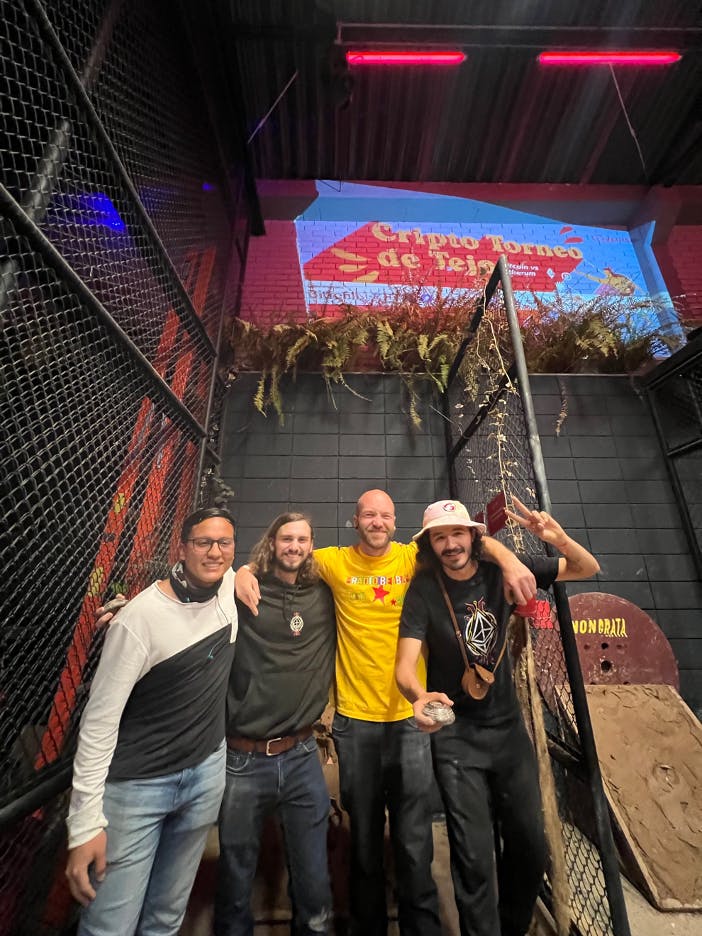 The DeveloperDAO tejo team
The DeveloperDAO tejo team
Zones to Stay In & Visit
El Chicó
El Chicó has been my favorite zone to live near while in Bogotá. The zone is in the north of the city but still not as north as Usaquén. In the center of El Chicó is Parque 93, a nice park on 93rd street surrounded by restaurants, bars, cafes, and stores. El Chicó is convenient—it’s within walking distance of Zona T (about a 20-minute walk south) and Usaquén (north). I’ve spent a lot of time living in Airbnbs and walking around the area I’ve highlighted on the map—there’s lots to do (image includes El Chicó stretching down to Zona T) and it feels safe during the day.
El Chicó has a lot of offices, so people tend to commute there in the morning to work and then hang out at bars and restaurants at night. Since there are a lot of offices, it can get quiet on weekday nights and I would recommend getting transportation if you plan to walk at night. Try to stay on or east of Autopista Norte because the west gets quiet and there’s not as much to see. Anywhere in the red box should be fine:
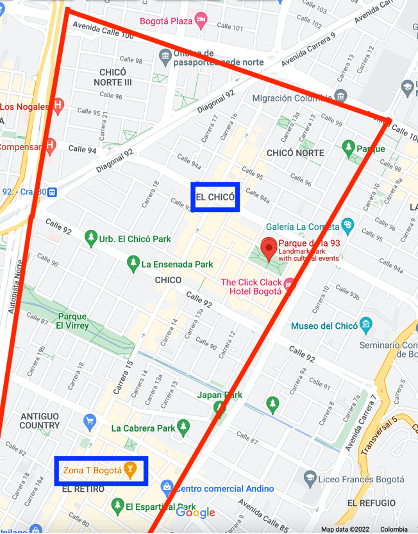
In El Chicó if you want food, you can generally just walk towards Parque 93 and you’ll find something. In general, around Parque 93 you can buy a meal for under $25,000 Colombian pesos (~$6 USD). There’s a large food hall and hotel called Salvio with around 15 places to eat that always attracts a lunch crowd.
 Parque 93
Parque 93
In Parque 93 there are nice cafes as well. An independent café called Azahar Café is popular with foreigners and has plenty of outlets for working. A latte there is $9,300 Colombian pesos (~$2 USD). Some other cafes by the park are Starbucks and Juan Valdez (Colombia’s most popular coffeehouse chain). In quality I think they’re similar. Starbucks is pricier than Juan Valdez but has better WiFi.
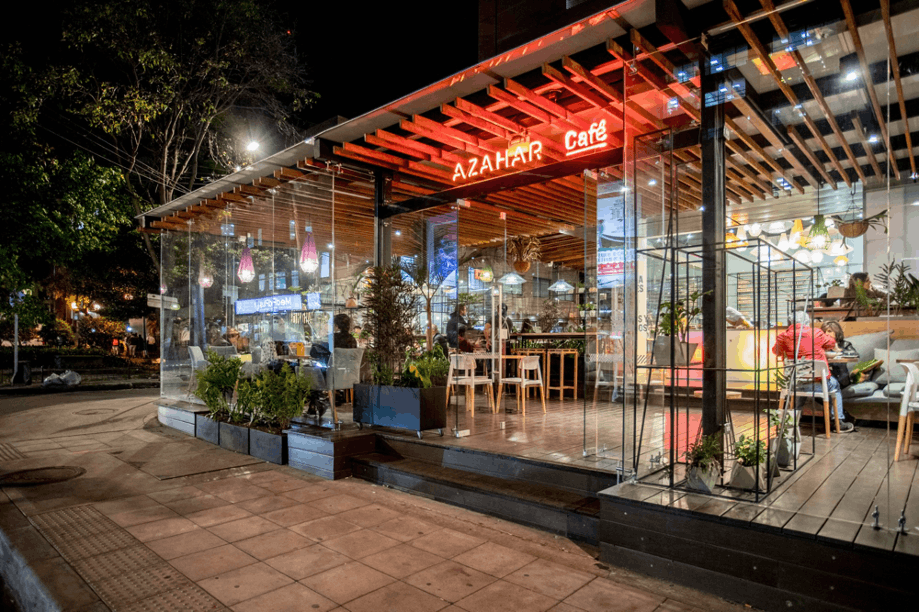
My favorite brewery near Parque 93 is El Mono Bandido (in English…the bandit monkey). It’s a beautiful space and a fun atmosphere. Sometimes the staff leads certain…games between tables. I’ll let you find out what I mean. The drinks and food are both great as well. There are also a lot of Bogotá Beer Company (BBC) breweries in Parque 93 and throughout Bogotá. Their drinks are good, but they tend not to serve much food.
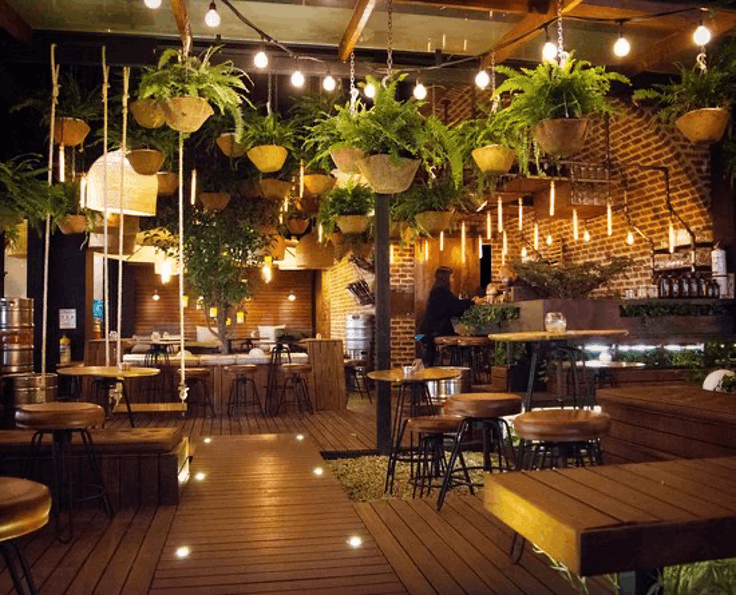 Interior of El Mono Bandido
Interior of El Mono Bandido
In between El Chicó and Zona T is Parque El Virrey, a 25-acre park that’s nice to walk through.
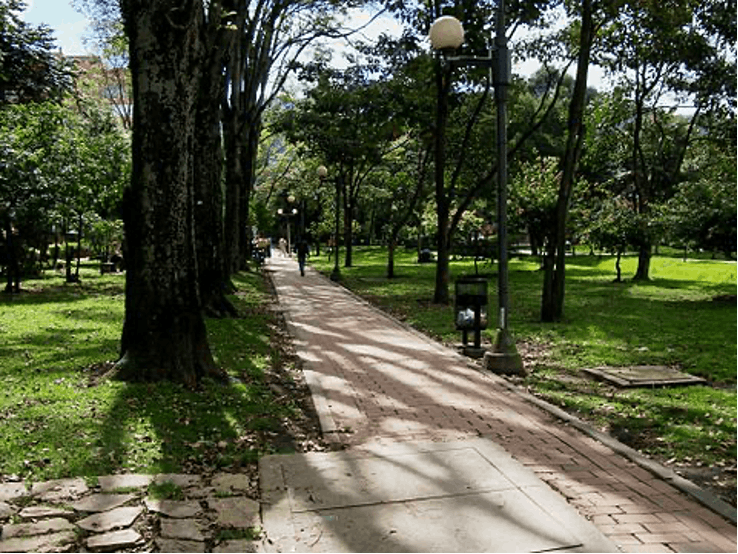 Parque El Virrey
Parque El Virrey
Zona T
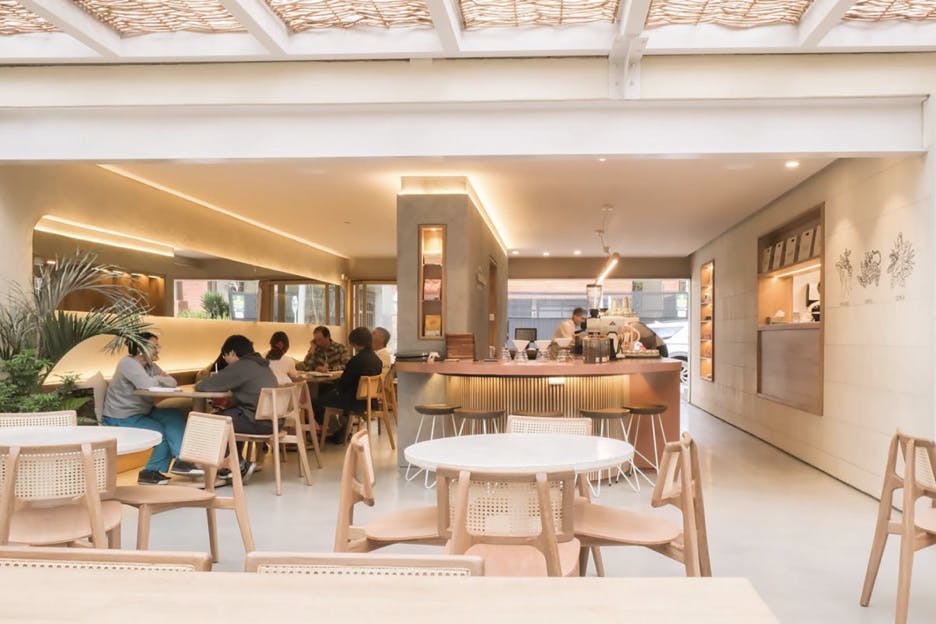 Tropicalia Coffee
Tropicalia Coffee
Zona T is just a little south of El Chicó and it’s a trendy area with a lot of restaurants, bars, and shopping centers. There are multiple shopping centers but the biggest is Centro Comercial Andino, which has a lot of shops and a large food court. There are a ton of restaurants in Zona T but some of my favorites are WOK (Pan-Asian food), MASA 81 (café, bakery, amazing sandwiches), and Chef Burger. There’s a beautiful café called Tropicalia Coffee (pictured above) that’s easy to spend a long time in. Zona T is roughly around the yellow areas in this map:
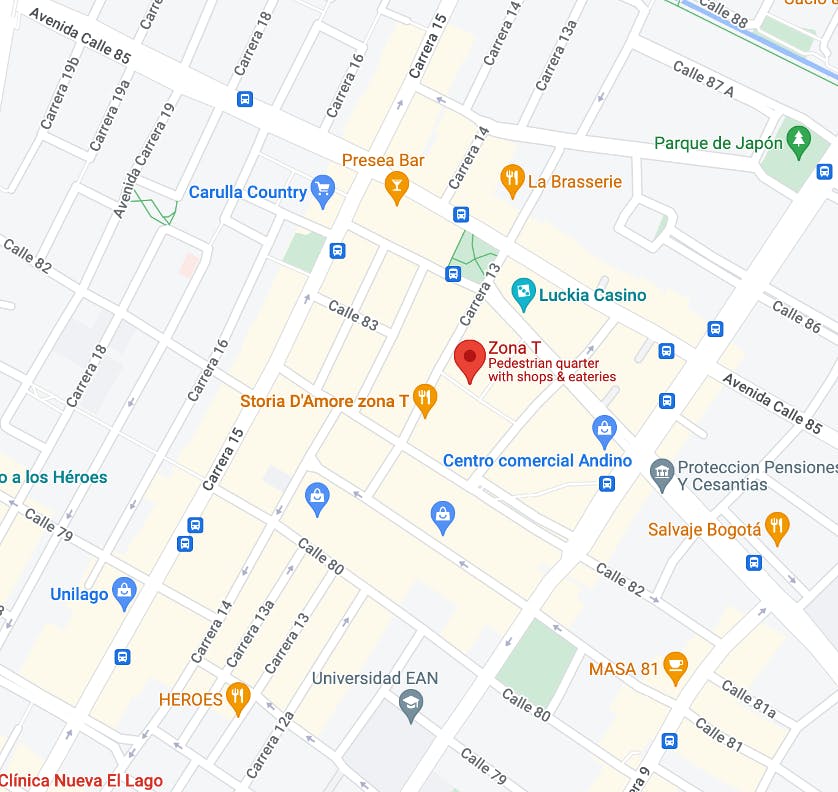
Usaquén

I haven’t spent as much time in Usaquén as I have in other zones. It’s a little quieter than El Chicó and Zona T. I’ve heard it’s a safe place to stay (generally northern zoner are safer than southern zones in Bogotá), but I’m not familiar enough with the area to recommend a specific part. Usaquén becomes super popular on Sundays for the Mercado de Las Pulgas en Usaquén (Usaquén Flea Market). The market around thirty minutes to walk through and it’s worth checking out to find a lot of handmade goods. The neighborhood where the market is located is nice as well.
Zona G

Zona G is like Zona T, but with more of an emphasis on restaurants and cafes rather than shopping or nightlife. It’s easy to walk around and there are a lot of historical brick buildings. There’s a big bookstore called Librería Wilborada 1047 that’s worth visiting. Whenever I go to Zona G I eat at Elektra Punk & Food, a delicious vegan restaurant with a punk aesthetic. Libertario Coffee Roasters is a spacious café in the area that’s great for getting work done. Juan Valdez also has their gigantic flagship café on Calle 70.
 Libertario Coffee Roasters
Libertario Coffee Roasters
Chapinero
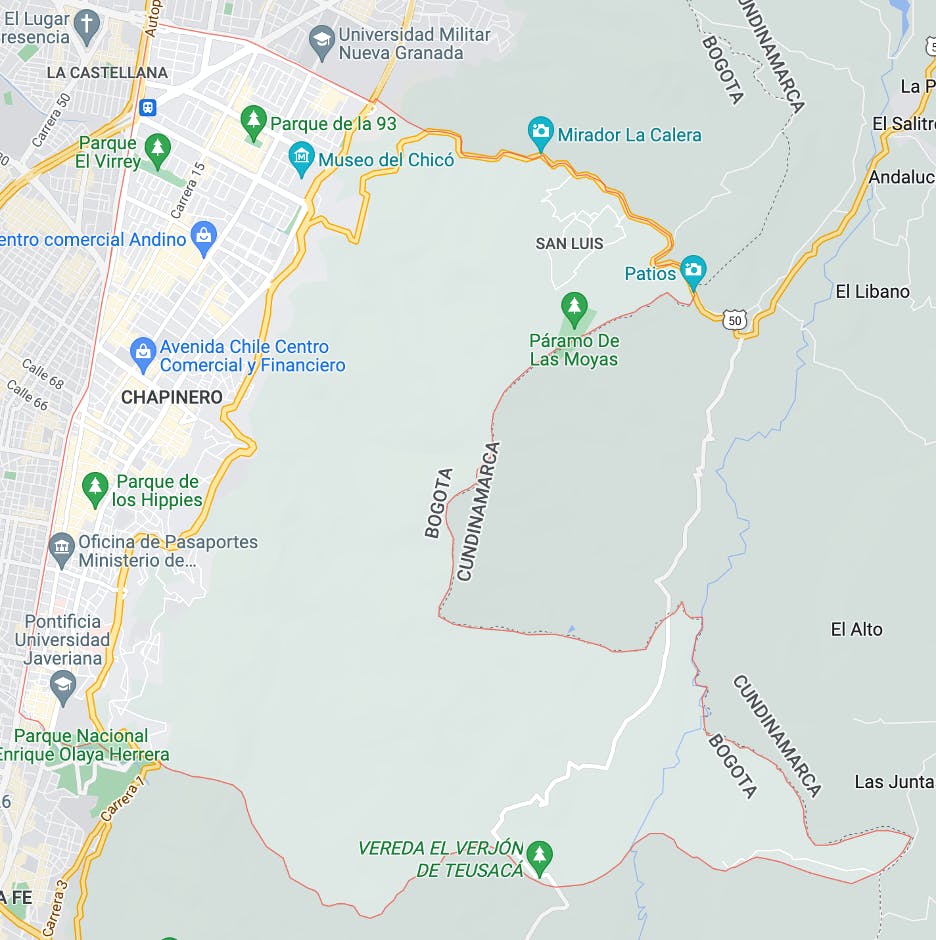
Chapinero is a massive zone that technically encompasses Zona G, Zona T, and El Chicó. The reason I’m mentioning Chapinero separately is because I’ve heard people describing it as a single neighborhood—like “Chapinero is hipster” or “Chapinero is a great place to stay.” Not all Chapinero is equal. If you see an Airbnb that mentions that it’s in Chapinero take the time to check out the general location. Generally, the northern parts of Chapinero are nicer than the south.
La Candelaria
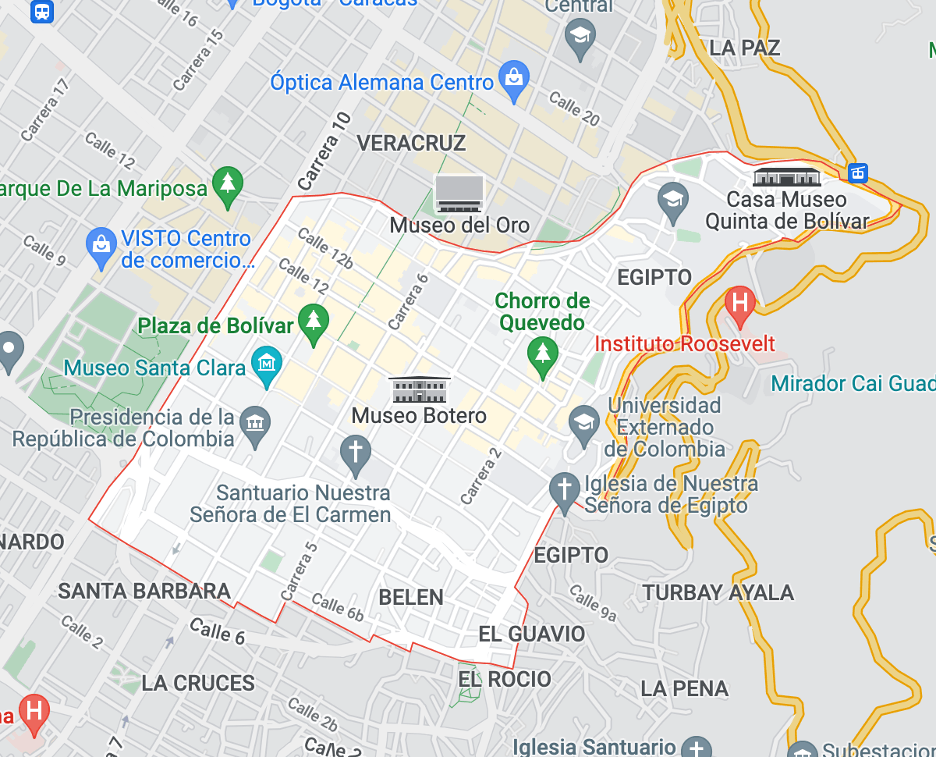
La Candelaria is the heart of Bogotá, with lots of museums, historical buildings, and restaurants. My favorite museum in Bogotá is Museo Botero. It’s beautiful, free to enter, and their collection is huge. If you don’t know Botero, he’s a famous Colombian artist who paints people and objects in an exaggerated way (you may already know his work through certain memes). Museo Botero and many other museums in Bogotá don’t let visitors in an hour before closing so factor that in before going.
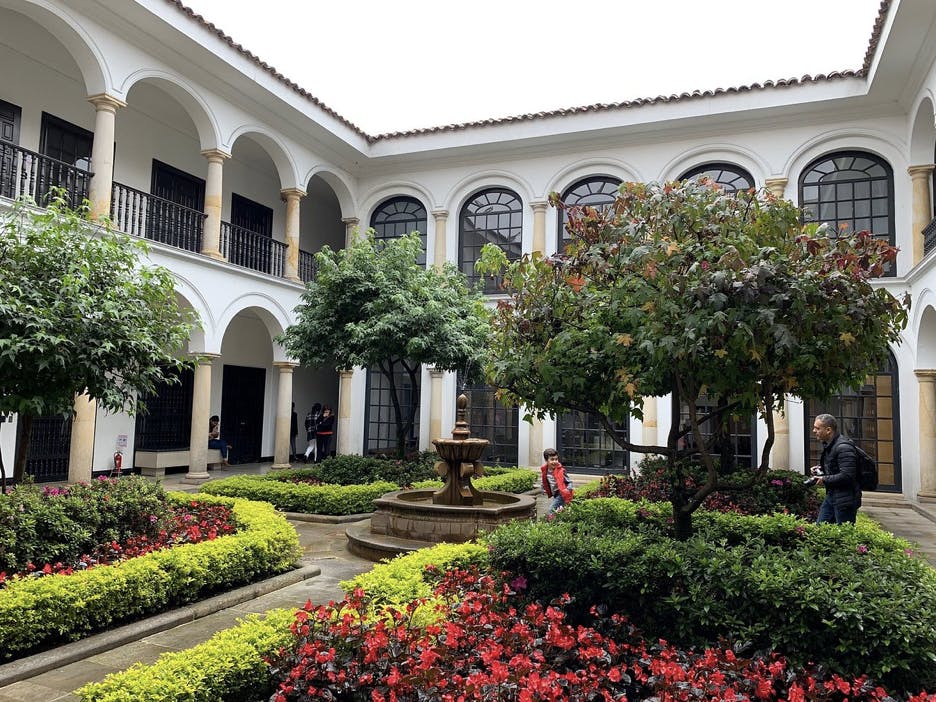 Museo Botero
Museo Botero
Another famous museum in the area is Museo del Oro (Gold Museum). The entrance fee is around $1 USD and as you might have guessed, there is gold. More gold than all the fancy shops you may have visited at EthCC. But really, the museum has stunning exhibits, and you’ll learn a lot about Colombian archaeology and the gold supply chain.
 Museo del Oro
Museo del Oro
The central plaza of Bogotá is Plaza de Bolívar, a large square surrounded by the Palacio de Justicia (Colombia’s Supreme Court) and the Casa de Nariño (the home and workplace of the President—Gustavo Petro as of August 7th). An interesting historical fact about the Palacio de Justicia is it was raided by the M-19 guerrilla group in 1985 and the entire Supreme Court was taken hostage. The story had a tragic ending, but it’s an example of the conflict that Colombia has largely left behind in the past couple of decades.
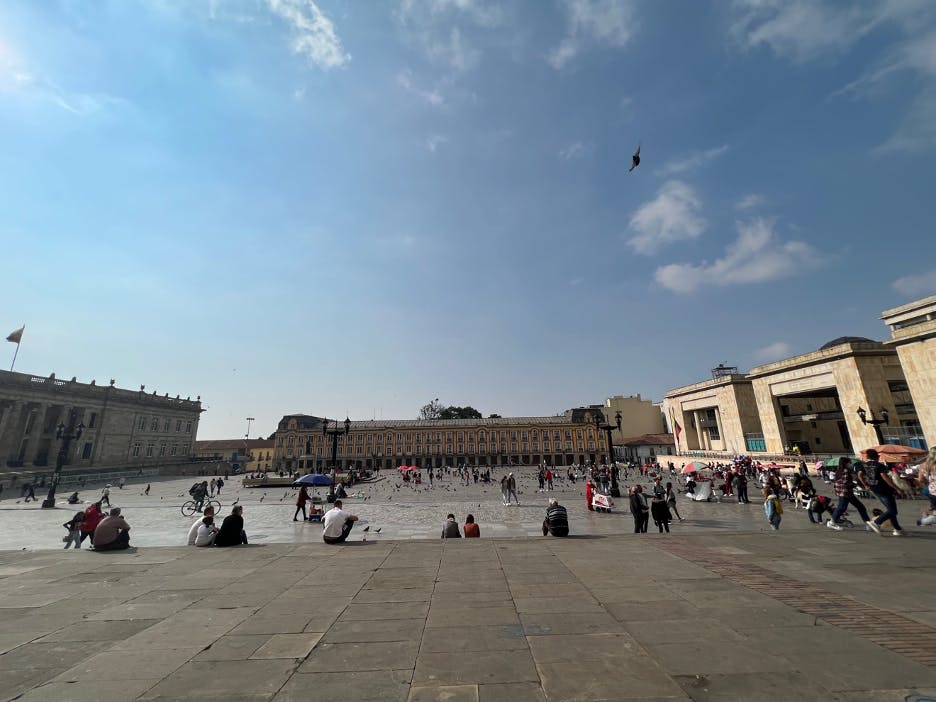 Plaza de Bolívar
Plaza de Bolívar
There’s also Primatial Cathedral de Bogotá, a beautiful cathedral in Plaza de Bolívar that visitors can walk through. A short walk from the plaza is the restaurant La Puerta Falsa, which is over two hundred years old and famous for its traditional Colombian meals. I would recommend ordering ajiaco, a delicious soup popular in Bogotá with potato, chicken, corn, and other garnishes. If you want to watch a movie, you can walk twenty minutes to the Cinemateca de Bogotá, a large theater that plays a lot of international and Colombian films. Fun fact: theaters are required to show a Colombian short film with every international film, so if you go to watch Encanto and you find yourself watching something completely different then just stick around for a little longer.
I wouldn’t recommend staying in La Candelaria. At night the center of the city completely empties out and it doesn’t feel safe to walk through. Even during the day there are some areas in the center that don’t feel very safe. It’s best not to stray too far from the museums or Cinemateca.
Other Things to Do
There are some other great places to visit in Bogotá that aren’t in the zones I mentioned above. El Jardín Botánico de Bogotá is a huge botanical garden that’s easy to walk around. It has plants from all over Colombia. The entrance fee is around $2 USD for foreigners. Make sure to bring an ID to get in. Here’s a picture of where the tropical plants are stored:
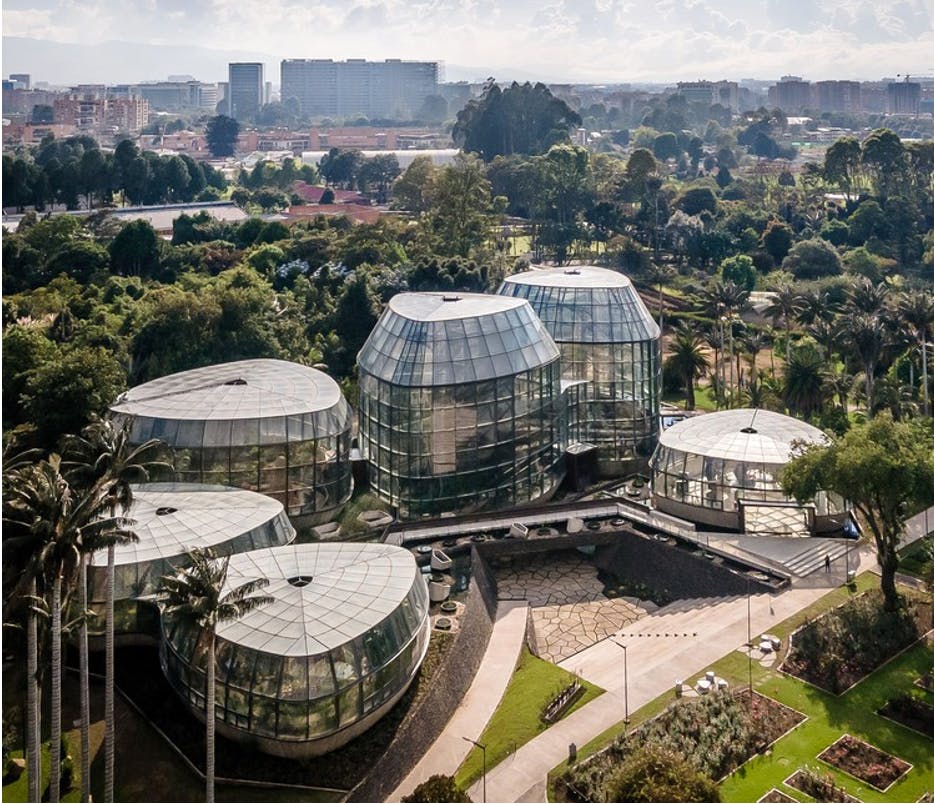
Overlooking Bogotá is Monserrate, a mountain over 10,000 feet high with the Sanctuary of Monserrate appearing at the top. You can get there via cable car, railway, or hiking (about an hourlong hike). Other than the sanctuary, there’s a large plaza and restaurants at the top.
 Monserrate and the Sanctuary of Monserrate
Monserrate and the Sanctuary of Monserrate
Transportation
You can get around the city in cab, TransMilenio, Uber, or DiDi. The TransMilenio is Bogotá’s massive bus system. There are dedicated bus lanes throughout the city, and it tends to be the fastest way to get around. You can buy a card to use the TransMilenio at any station and each trip is only around $2500 Colombian pesos or $.50 USD. Try to avoid traveling during rush hour; it gets so packed that people stand flush against the door. The TransMilenio is also notorious for pickpockets. I know two Colombians who’ve had their phones stolen on it (and one of them had multiple phones stolen). It was a meme on TikTok for a little while to record people with their phones or laptops out on the TransMilenio because it’s just…not smart.
There are yellow cabs everywhere in Bogotá, but it’s not a good idea to hail cabs on the street. There are different ways hailing a taxi can go wrong: there are express kidnappings (rare), taxi drivers taking the long way home, taxi meters that have been tampered with, etc. You could call a taxi company directly or just use a ridesharing app (easiest). At the airport there will be trying to persuade you to come with them, but it’s still best practice to order a taxi, use a ridesharing service, etc.
Ride sharing apps have a precarious legal standing in Colombia. Licensed taxis must pay for an extremely expensive license to operate in the country. Ridesharing apps like Uber and DiDi don’t require drivers to pay for this license, which results in cheaper fares. Ridesharing apps aren’t explicitly outlawed, but they still operate in a legal grey area. If you use one of these apps drivers may ask you to sit in the passenger seat to avoid attracting police. Uber and DiDi are very cheap. I’ve never seen a fare higher than $10 USD and I’ve seen fares less than $2 USD.
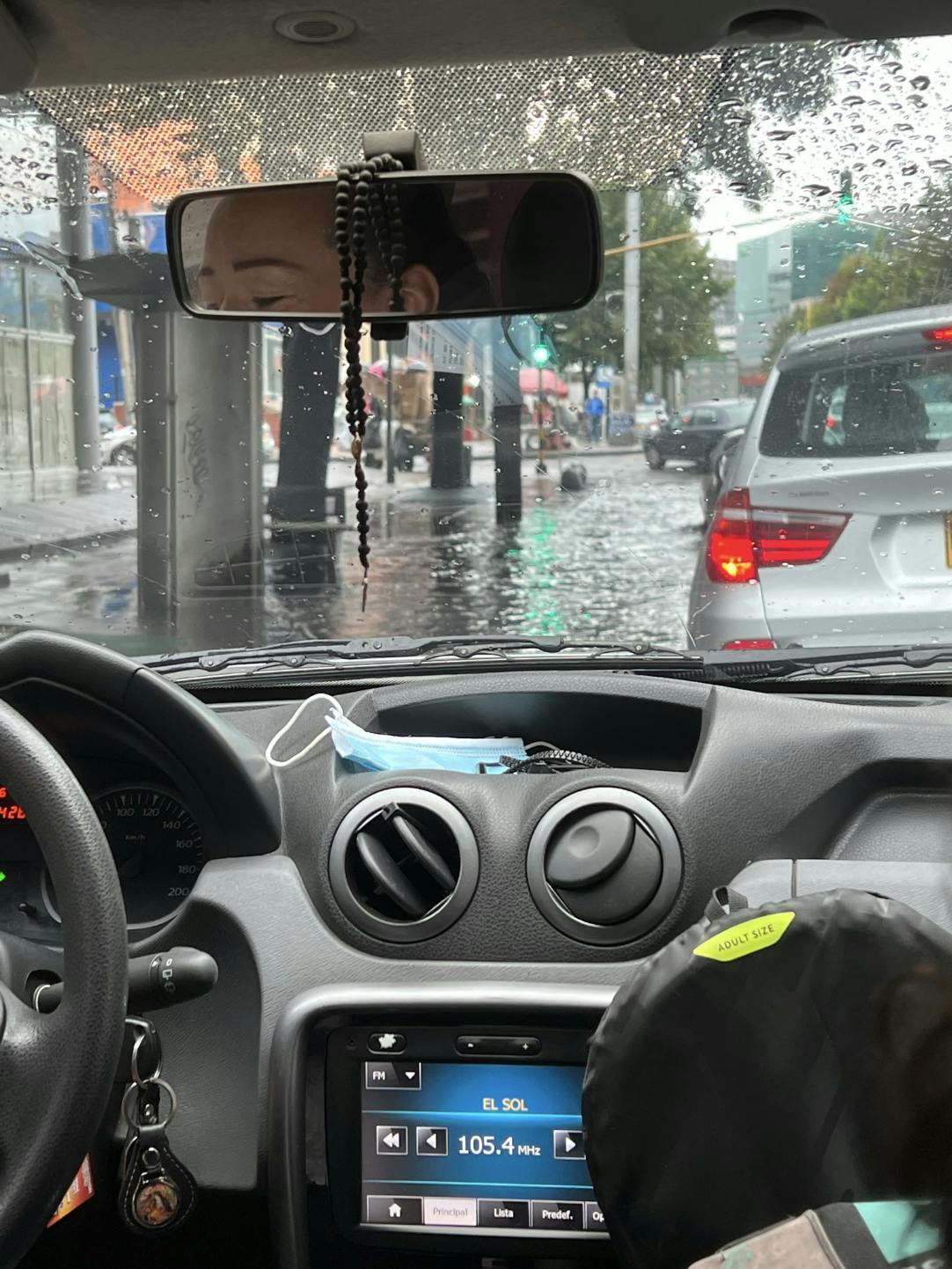 Watch out for puddles!
Watch out for puddles!
Weather
As I mentioned before, Bogotá is consistently around 60°F to 70°F (15.5°C to 21°C) during the day and windy. Just as Medellín has the nickname “the city of eternal spring,” Bogotá has the less romantic nickname “la nevera” (the refrigerator). The weather changes quickly from sunny to cloudy and cold. It often rains in the afternoon without warning. People typically dress in long clothing, or if they wear a t-shirt then they bring a light jacket with them. It’s a good idea to always have an umbrella with you. I’ve noticed people like dressing in darker colors and jeans are everywhere.
Safety
Bogotá has a high poverty rate of around 40% and street crimes remain high. However, violent crime in Bogotá has plummeted in the past decade. There are still hints of Colombia’s violent past throughout the city. For example, there are typically bomb dogs in popular buildings and nearly every apartment complex in the wealthier parts of the city have doormen that have residents and visitors register at the door.
There’s a popular Colombian phrase “no dar papaya” (don’t give papaya) that suggests taking care to avoid opportunistic crime. For example, keeping your phone and laptop in your bag on the street, not wearing expensive watches, and not looking lost. This is especially important the further south you are in the city and in the TransMilenio.
Given that ridesharing apps are so inexpensive, I just wouldn’t recommend walking at night, even in the northern parts of the city. Around 9pm I saw a robbery happen near Avenida Calle 100, just a little north of Parque 93 in what is considered a safe area. My Colombian friends don’t walk far at night either.
Bogotá has a great nightlife scene with clubs like Theatron, Video Club, and a ton of bars. However, men who are looking for a date should be aware that there is an issue with targeted druggings and robberies that typically applies to single, male travelers. Men are rendered unconscious with scopolamine or a benzodiazepine and left susceptible to robbery. It sounds bizarre but I’ve heard this happen to several men in the digital nomad community. If a date asks if you’re traveling alone, it should be a red flag. Also, dating apps common in the US are much less common in Colombia and should be used with caution.
Outside Bogotá
There are some nice day trip opportunities outside of Bogotá. You can visit Sopó, a small town about an hour north of Bogotá. In Sopó is La Cabaña Alpina, a supermarket, deli, café, and bakery with Alpina products (a huge Colombian dairy and food company whose headquarters is in Sopó). On the weekends you can visit La Cabaña Alpina without a reservation. Parque Puente Sopó is a nice park to visit as well (entrance fee for foreigners is a couple dollars). To get to Sopó you should go to the TransMilenio station Terminal del Norte and find one of the busses going to Sopó behind the large, sheltered station. Bring cash to pay the bus driver (somewhere between 5,000 and 20,000 Colombian pesos).
 La Cabaña Alpina
La Cabaña Alpina
There are many other day trip opportunities from Bogotá. Some others that I’ve heard are good are Lake Guatavita and Villa de Leyva.
I hope my guide helped you plan! If you have any other questions about Bogotá, you can reach out to me on Twitter (@jahabeebs)
Photo Credits:
Azahar Café: https://www.tripadvisor.com/Restaurant_Review-g294074-d7626979-Reviews-Azahar_Coffee_Company-Bogota.html#photos;aggregationId=&albumid=101&filter=7&ff=310806023
El Mono Bandido: https://www.tripadvisor.co/Restaurant_Review-g294074-d15104784-Reviews-El_Mono_Bandido-Bogota.html
Parque El Virrey: https://es.wikipedia.org/wiki/Parque_urbano_El_Virrey
Tropicalia Coffee: https://sprudge.com/build-outs-of-coffee-tropicalia-coffee-in-bogota-colombia-188930.html
Libertario Coffee Roasters: https://www.google.com/maps/uv?pb=!1s0x8e3f9a426460b391%3A0xb87ce05d7f868b84!3m1!7e115!4shttps%3A%2F%2Flh5.googleusercontent.com%2Fp%2FAF1QipPeZfJp5KFLTVCB3mqGDsUhVvWiy6izhWkD-DeD%3Dw172-h174-n-k-no!5slibertario%20coffee%20roaster%20-%20Google%20Search!15sCgIgAQ&imagekey=!1e10!2sAF1QipPGhcBHy0iFRPF95G8appPp6TXBPoh5Uc-cncLz&hl=en&sa=X&ved=2ahUKEwjqrYWstL35AhVGpIkEHfn6CpIQ7ZgBKAV6BAgaEAc
Botero Museum: https://dynamic-media-cdn.tripadvisor.com/media/photo-o/17/21/8b/a4/photo0jpg.jpg?w=1200&h=-1&s=1
Museo del Oro: https://www.banrepcultural.org/bogota/museo-del-oro/programe-su-visita
Jardín Botánico: https://www.archdaily.co/co/960524/tropicario-jardin-botanico-de-bogota-darp
Monserrate: https://www.eltiempo.com/vida/ciencia/es-el-cerro-de-monserrate-un-volcan-409450

